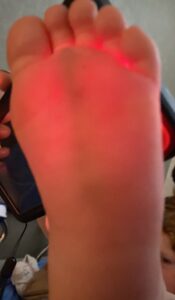
A 4-year-old female, who is otherwise healthy, presented to the emergency department (ED) for evaluation of left foot pain. Three days prior, the patient had been on a wooden dock with family friends. She suddenly developed pain to the plantar aspect of the foot without any obvious trauma. She had not ambulated since then. At urgent care, two small splinters were removed from the foot and a small amount of purulence was noted. She was discharged home with expectant management. After continuing to have poor pain control, the mother brought her to the ED. She was vitally stable and afebrile, but unable to be consoled. On physical exam, she cried continuously and had significant tenderness to the plantar aspect at the distal second and third metatarsals. Purulence was able to be expressed from a small opening as well.
Diagnosis: Wooden Splinter
The X-ray of the foot was read as “Salter-Harris III fracture involving the proximal 1st metatarsal. There was no evidence of foreign body” (Figure 1). In discussion with orthopedics, this was thought to be a variant and not the cause of her pain. With further discussion with the mother, she mentioned they had transilluminated the foot at home and thought they saw “something.” Indeed, with transillumination of the foot in the exam room with a light from a cell phone showed a faint linear foreign body was appreciated at approximately four cm in length (Figure 2). Podiatry was consulted and they recommended an MRI and antibiotics, plan for operative removal given the purulence and her level of discomfort. MRI did not appreciate a foreign body due to what was initially thought to be motion artifact (Figure 3). She was still brought to the operating room and an eight cm wooden splinter was removed from her foot. She was discharged from the hospital the following day on levaquin and cephalexin. Her wound culture ultimately grew Clostridium tertium.
Discussion
Foreign body-related injuries are often missed on first visits and are common causes of malpractice claims. There were more than eight million ED visits for open wounds.3 One study evaluating foreign bodies in cadaver feet evaluated sensitivity and specificity for detection via radiographs, CT, and MRI. Overall detection for radiography was 29 percent (sensitivity) and 100 percent (specificity), 63 percent and 98 percent for CT, and 58 percent and 100 percent for MRI.4 Interestingly, CT was superior to MRI in identifying water-rich fresh wood. Ultrasound has become a highly reliable modality for detecting non-radiopaque foreign bodies. Sensitivity and specificity were 63 percent and 95 percent respectively in a study from 2013.4 Although, this is often operator dependent and can be difficult given echo patterns which vary with size, nature, and retention time.2 In areas such as hands and feet, transillumination can also help identify the presence of a retained foreign body, as in this case.
Pages: 1 2 | Single Page








One Response to “Using Transillumination to Diagnose a Foreign Body”
March 10, 2024
Will GradTwo of my most satisfying cases in my over 30 yrs of EM practice were finding and removing foreign bodies in the feet of 2 adult men who both had been suffering for over a year with pain that could not be explained. Both had been to multiple other physician specialists who had failed to diagnosis the problem. I made the diagnosis in each case relatively quickly using bedside ultrasound. Interestingly, in both cases the patients could not remember the traumatic events which had led to the foreign bodies becoming imbedded. (One wood, one a small pebble.)